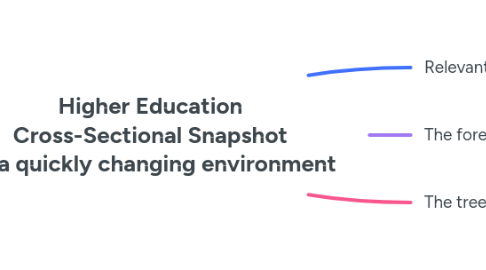
1. Relevant advances in AI
1.1. Further integration with robotics
1.2. Claude 3's benchmarks
1.3. The effects of open sourced AI
1.3.1. Example 1
1.3.1.1. https://replicate.com/p/tt8hsj8whnrge0cenj7rrk43rr
1.3.2. Example 2
1.3.2.1. https://replicate.com/p/6fpvf5dk2drgc0cenhja9cdvvc
2. The forest
2.1. Disruptive Technologies, Higher Education, and Harnessing the Promise of a Revolution (Bonilla & Stoner, 2016)
2.1.1. Pressures for ICT use in higher education
2.1.1.1. Constant change and technological innovations
2.1.1.2. Outpacing ability to identify and appropriate affordances
2.1.1.3. Information sources: vendors vs. empirical research
2.1.1.4. Faculty challenges: vetting evolving software and hardware
2.1.2. Disruptive Technologies (DT) in higher education
2.1.2.1. Definition and distinction from "new" or "alternative" technologies Promulgators and affirmative vision of DT
2.1.3. Key questions regarding DT in higher education
2.1.3.1. What is a disruptive technology in higher education?
2.1.3.2. Processes and drivers for DT adoption in higher education
2.1.3.3. Distinguishing technologies for class management vs. instruction and learning
2.1.3.4. Predicting multidimensional effects of implementing DT
2.1.3.5. Privacy/security concerns
2.1.3.6. Costs of failed adoption attempts
2.1.4. Need for systematic examination of DT in higher education
2.1.4.1. Fast technological development as a given
2.1.4.2. Determining effects of DT in higher education
2.1.4.3. Investigating instructional problems mitigated, solved, or created by DT
2.1.4.4. Examining the promise of a revolution in higher education efficiency and effectiveness
2.1.5. Call for studies on DT in higher education
2.1.5.1. Developing understanding of the nature and role of DT
2.1.5.2. Moving beyond hype cycles
2.1.5.3. Systematically examining potentialities and limitations of DT
2.1.5.4. Inviting studies from various perspectives, methods, and disciplines
3. The trees
3.1. Intelligent Automation Examples
3.1.1. Dr. Sarabia's et al interviews
3.1.1.1. ChatGPT is programmed to perform the interviews and gather all the required research-realted input
3.1.1.2. Since ChatGPT runs the interviews, the outputs are consistently laid out
3.1.1.3. Immediate analysis
3.1.1.3.1. Individual
3.1.1.3.2. Aggregate
3.1.1.4. Immediate reporting
3.1.2. Dr. Stoner research about power relations in the classroom
3.1.2.1. Program a ChatGPT to find speakers in a class transcript
3.1.2.2. Robust content analysis based on operational definitions
3.1.2.3. Report of the power relationships findings for this class transcript
3.1.2.4. Apply the system to any class transcript on an ongoing basis
3.1.3. Dr. Bonilla's
3.1.3.1. Requiem Diurnus
3.1.3.2. AInews.Social
3.1.3.2.1. Any news topic, any news source, analyzed daily
3.2. Broader conversation about the trees
3.2.1. Speed of change
3.2.2. New academic environment
3.2.2.1. The fast academic pace and keeping currency to be an effective instructor
3.2.2.2. LLM alters the balance between professor and student
3.2.2.3. Producing meaningful knowledge or creative work
3.2.2.4. Ongoing technological training
3.2.3. New pedagogy considering AI
3.2.3.1. Advantages and disadvantages of Intelligent automation
3.2.3.2. Tension between tradition and innovation
3.2.4. Faculty work balance
3.2.5. Understanding of innovation by academic heads
3.2.6. Administration
3.2.7. Employees' and Students' privacy
3.2.8. Problems with Large Language Models
3.2.8.1. Biases
3.2.8.1.1. Qualitative biases
3.2.8.1.2. Quantitative biases
3.2.8.2. Mistakes
3.2.8.2.1. "Hallucinations"
